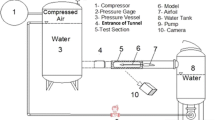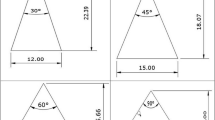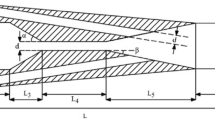Abstract
Our study provides the first experimental investigation of the internal flows of ventilated partial cavitation (VPC) formed by air injection behind a backward-facing step. The experiments are conducted using flow visualization and planar particle image velocimetry with fog particles for two different cavity regimes of VPC, i.e., open cavity (OC) and two-branch cavity (TBC), under various ranges of free stream velocity (U) and ventilation rates (Q). Our experiments reveal similar flow patterns for both OC and TBC, including forward flow region near the air–water interface, reverse flow region, near-cavitator vortex, and internal flow circulation vortex. However, OC internal flow exhibits highly unsteady internal flow features, while TBC internal flow shows laminar-like flow patterns with a Kelvin–Helmholtz instability developed at the interface between forward and reverse flow regions within the cavity. Internal flow patterns and the unsteadiness of OC resemble those of turbulent flow separation past a backward-facing step (BFS flow), suggesting a strong coupling of internal flow and turbulent external recirculation region for OC. Likewise, internal flow patterns of TBC resemble those of laminar BFS flow, with the presence of unsteadiness due to the strong velocity gradient across the forward–reverse flow interface. The variation in the internal flow upon changing U or Q is further employed to explain the cavity regime transition and the corresponding change of cavity geometry. Our study suggests that the ventilation control can potentially stabilize the cavity in the TBC regime by delaying its internal flow regime transition from laminar-like to highly unsteady.
Graphic abstract











Similar content being viewed by others
References
Amromin E, Kopriva J, Arndt RE, Wosnik M (2006) Hydrofoil drag reduction by partial cavitation. J Fluids Eng 128(5):931–936
Barbaca L, Pearce BW, Brandner PA (2017) Experimental study of ventilated cavity flow over a 3-D wall-mounted fence. Int J Multiph Flow 97:10–22
Barbaca L, Pearce BW, Brandner PA (2018) An experimental study of cavity flow over a 2-D wall-mounted fence in a variable boundary layer. Int J Multiph Flow 105:234–249
Beaudoin JF, Cadot O, Aider JL, Wesfreid JE (2004) Three-dimensional stationary flow over a backward-facing step. Eur J Mech B/Fluids 23(1):147–155
Boiko A, Dovgal A, Hein S, Henning A (2011) Particle image velocimetry of a low-Reynolds-number separation bubble. Exp Fluids 50(1):13–21
Ceccio SL (2010) Friction drag reduction of external flows with bubble and gas injection. Annu Rev Fluid Mech 42:183–203
Etheridge D, Kemp P (1978) Measurements of turbulent flow downstream of a rearward-facing step. J Fluid Mech 86(3):545–566
Goldstein R, Eriksen V, Olson R, Eckert E (1970) Laminar separation, reattachment, and transition of the flow over a downstream-facing step. J Basic Eng 92(4):732–739
Huerre P, Monkewitz PA (1990) Local and global instabilities in spatially developing flows. Annu Rev Fluid Mech 22(1):473–537
Jiang Y, Shao S, Hong J (2018) Experimental investigation of ventilated supercavitation with gas jet cavitator. Phys Fluids 30(1):012103
Jovic S, Driver D (1995) Reynolds number effect on the skin friction in separated flows behind a backward-facing step. Exp Fluids 18(6):464–467
Karn A, Ellis C, Hong J, Arndt RE (2015) Investigations into the turbulent bubbly wake of a ventilated hydrofoil: moving toward improved turbine aeration techniques. Exp Therm Fluid Sci 64:186–195
Karn A, Arndt RE, Hong J (2016) An experimental investigation into supercavity closure mechanisms. J Fluid Mech 789:259–284
Kopriva J, Arndt RE, Amromin EL (2008) Improvement of hydrofoil performance by partial ventilated cavitation in steady flow and periodic gusts. J Fluids Eng 130(3):031301
Kostas J, Soria J, Chong M (2002) Particle image velocimetry measurements of a backward-facing step flow. Exp Fluids 33(6):838–853
Laberteaux K, Ceccio S (2001) Partial cavity flows. Part 1. Cavities forming on models without spanwise variation. J Fluid Mech 431:1–41
Ma X, Schröder A (2017) Analysis of flapping motion of reattaching shear layer behind a two-dimensional backward-facing step. Phys Fluids 29(11):115104
Makiharju S, Elbing B, Wiggins A, Dowling D, Perlin M, Ceccio S (2010) Perturbed partial cavity drag reduction at high Reynolds numbers. In: Proceedings of the 28th symposium on Naval Hydrodynamics, Pasadena, CA
Mäkiharju SA, Perlin M, Ceccio SL (2012) On the energy economics of air lubrication drag reduction. Int J Naval Archit Ocean Eng 4(4):412–422
Mäkiharju SA, Elbing BR, Wiggins A, Schinasi S, Vanden-Broeck JM, Perlin M, Dowling DR, Ceccio SL (2013) On the scaling of air entrainment from a ventilated partial cavity. J Fluid Mech 732:47–76
Nadge PM, Govardhan R (2014) High Reynolds number flow over a backward-facing step: structure of the mean separation bubble. Exp Fluids 55(1):1657
Patel V, Head MR (1968) Reversion of turbulent to laminar flow. J Fluid Mech 34(2):371–392
Qin S, Wu Y, Wu D, Hong J (2019) Experimental investigation of ventilated partial cavitation. Int J Multiph Flow 113:153–164
Scarano F, Benocci C, Riethmuller M (1999) Pattern recognition analysis of the turbulent flow past a backward facing step. Phys Fluids 11(12):3808–3818
Schäfer F, Breuer M, Durst F (2009) The dynamics of the transitional flow over a backward-facing step. J Fluid Mech 623:85–119
Wang Z, Huang B, Zhang M, Wang G, Zhao X (2018) Experimental and numerical investigation of ventilated cavitating flow structures with special emphasis on vortex shedding dynamics. Int J Multiph Flow 98:79–95
Wu Y, Liu Y, Shao S, Hong J (2019) On the internal flow of a ventilated supercavity. J Fluid Mech 862:1135–1165
Acknowledgements
This work is supported by the Office of Naval Research (Program Officer, Deborah Nalchajian) under Grant No. N000141612755.
Author information
Authors and Affiliations
Corresponding author
Additional information
Publisher's Note
Springer Nature remains neutral with regard to jurisdictional claims in published maps and institutional affiliations.
Electronic supplementary material
Below is the link to the electronic supplementary material.
Supplementary material 1 (avi 117725 KB)
Supplementary material 2 (avi 114094 KB)
Supplementary material 3 (avi 101548 KB)
Supplementary material 4 (avi 90036 KB)
Supplementary material 5 (avi 85685 KB)
Supplementary material 6 (avi 58486 KB)
Supplementary material 7 (avi 59379 KB)
Rights and permissions
About this article
Cite this article
Yoon, K., Qin, S., Shao, S. et al. Internal flows of ventilated partial cavitation. Exp Fluids 61, 100 (2020). https://doi.org/10.1007/s00348-020-2931-y
Received:
Revised:
Accepted:
Published:
DOI: https://doi.org/10.1007/s00348-020-2931-y




